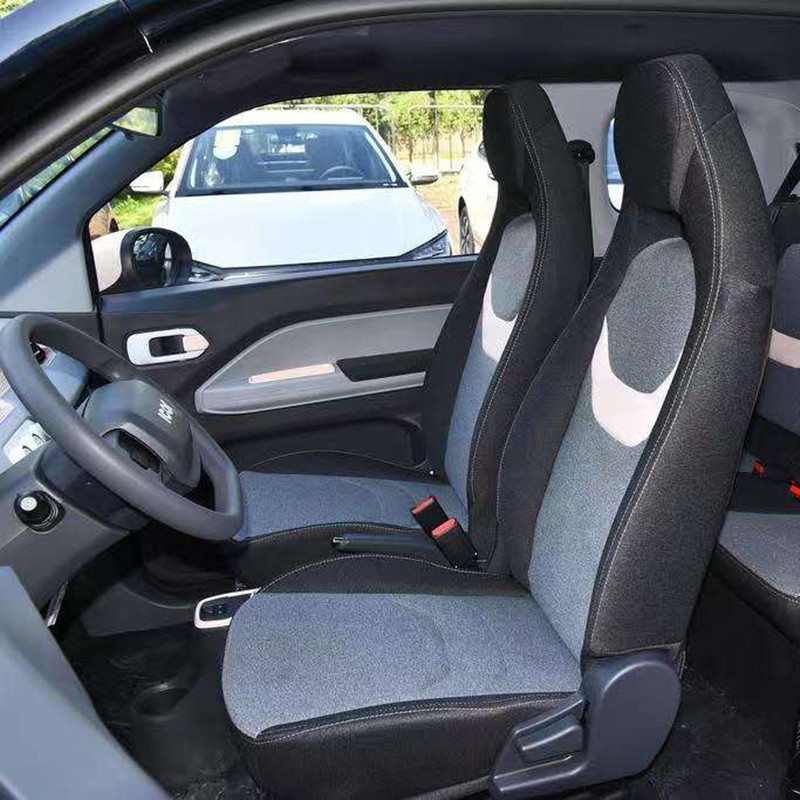Loader Seats
Loader Seats
As a core component of human-machine interaction in construction machinery, the design of wheel loader seats directly affects operational safety, comfort, and work efficiency. The following is an analysis from multiple dimensions including technology, market, and maintenance:
I. Technical Design and Performance
1. Structural Classification and Shock Absorption Technology
Wheel loader seats are mainly divided into two categories: mechanical suspension seats and air suspension seats.
- Mechanical suspension seats absorb vibration through springs and dampers. They have lower costs but limited buffering effects, and are commonly used in mid-to-low-end models.
- Air suspension seats adopt an airbag system, which can automatically adjust stiffness according to the load. For example, the Cat® Premium Plus seat supports 8-way adjustment and lumbar support, and can effectively attenuate over 90% of vertical vibrations. High-end models can also integrate hydraulic dampers to further improve stability under extreme working conditions (such as mining operations).
2. Ergonomic Design
Seats that comply with the ISO 3419 standard must meet the following requirements: seat width ≥ 450mm, seat depth ≥ 400mm, backrest angle adjustment range of 100°-120°, and the adjustment mechanism must be operable without tools. Some high-end seats are equipped with reversible armrests, heating/ventilation functions, and thick cushion designs that conform to the human body curve, reducing fatigue during long-term operations. In addition, 3D pressure distribution tests show that high-quality seats can control the peak contact pressure on the hips below 9kPa.
3. Safety Standards and Certifications
Wheel loader seats must pass strict mechanical performance tests:
- Static load-bearing: Capable of withstanding a static load 10 times the driver’s weight (e.g., 136kg × 10 = 1360kg).
- Dynamic impact: No structural damage after 500,000 cycles of load testing.
- Locking mechanism: The slide rail locking device must withstand a horizontal impact force of 2000N without displacement.
In addition, compatibility tests for ROPS (Roll-Over Protective Structure) and FOPS (Falling Object Protective Structure) are also mandatory requirements.
II. Market Pattern and Product Selection
1. Brand Competition and Market Distribution
China’s wheel loader seat market presents a "one dominant, multiple strong" pattern:
- Hengli Hydraulic ranks first with a 28.4% market share. Its intelligent seat system integrates pressure sensing and remote diagnosis functions, and has been matched with Sany Heavy Industry’s high-end models.
- Zhejiang Dingli and Anhui Heli account for 17.6% and 12.3% of the market share respectively.
- International brands such as Grammer and KAB have advantages in the high-end market, with their air suspension seats priced at 1,500-2,000 US dollars per unit.
2. Product Classification and Application Scenarios
- Basic type (45% market share): Mechanical suspension, only supporting basic adjustments. Suitable for small loaders below 3 tons, priced at approximately 500-1,000 RMB.
- Comfort type (35% market share): Air suspension + multi-way adjustment. Suitable for mainstream models of 5-8 tons, priced at approximately 3,000-8,000 RMB.
- Intelligent type (20% market share): Integrating electric adjustment and health monitoring (e.g., heart rate, sitting posture analysis). Mainly matched with high-end models above 10 tons, with a unit price exceeding 15,000 RMB.
3. Key Factors for Selection
- Working condition adaptation: For mining operations, prioritize air suspension seats with additional shock absorbers; for urban working conditions, lightweight mechanical suspension seats can be considered.
- Compatibility: Confirm that the seat size matches the cab. For example, the width of the Cat® 521-0669 model is 507.7mm, so sufficient space must be reserved.
- Cost-effectiveness: Air suspension seats have an initial cost 30%-50% higher, but they can reduce the failure rate related to driver fatigue by 30%, resulting in lower long-term comprehensive costs.
III. Maintenance and Refurbishment
1. Daily Maintenance Points
- Lubrication and maintenance: Add lithium-based grease to the adjustment slide rails and hinge points every 250 hours to prevent jamming.
- Airbag inspection: Check the air suspension pressure (standard value: 0.4-0.6MPa) monthly and replace aging seals in a timely manner.
- Fabric cleaning: Wipe with a neutral detergent to avoid damage to leather/fabric caused by organic solvents. The fabric of Cat® seats adopts fusion technology and can be directly washed with water.
2. In-Depth Maintenance and Refurbishment
- Frame repair: Repair deformed frames through welding and straightening, which must comply with the ISO 7096 structural strength standard.
- Component replacement: For severely worn adjustment motors and sensors, it is recommended to replace them with original accessories directly to avoid compatibility issues.
- Refurbishment cost: Refurbishing a set of seats costs approximately 2,000-5,000 RMB, which is 30%-50% of the price of new products, but the service life can reach 80% of that of new products.
3. Troubleshooting Guide
- Adjustment failure: 90% of the problems are caused by slide rail wear or motor failure, which can be repaired by replacing the slider (approximately 200 RMB/set) or the motor (approximately 800 RMB/unit).
- Airbag air leakage: Check the sealing of the air valve interface and replace the damaged airbag (approximately 1,500 RMB/piece).
- Abnormal noise: Mostly caused by loose hinges or fatigued springs, which can be solved by tightening bolts or replacing springs (approximately 300 RMB/piece).
IV. Industry Trends and Cutting-Edge Technologies
1. Intelligent Upgrading
The new generation of seats integrates a variety of sensors:
- Pressure sensors: Automatically identify the driver’s weight and adjust the suspension stiffness (e.g., Grammer MSG 95 model).
- Posture sensors: Monitor the sitting posture and provide real-time reminders for correction, reducing the risk of lumbar diseases.
- Environmental sensors: Automatically adjust the heating/ventilation intensity according to temperature and humidity.
2. Material Innovation
- Carbon fiber composite materials: The weight of the seat frame can be reduced by 30% while increasing the strength by 20%, which has been pilot-applied in some high-end models.
- Environmentally friendly materials: The utilization rate of recyclable polyester fiber fabrics and bio-based polyurethane foam is gradually increasing, complying with the requirements of the EU RoHS directive.
3. Electrification Adaptation
Electric wheel loaders put forward higher requirements for seats:
- Low-noise design: Use sound insulation cotton and hydraulic dampers to reduce cab noise to below 75dB.
- Energy recovery: Power on-board electronic equipment through a seat vibration energy harvesting system.
V. Typical Cases and Solutions
1. Cat® 507.6mm Wide Premium Plus Air Suspension Seat
- Core advantages: 8-way electric adjustment + heating/ventilation + lumbar support. Suitable for large loaders such as the Cat® 950GC. Actual tests show that it can reduce the transmission of whole-body vibration by 42%.
- Maintenance cost: The annual maintenance cost is approximately 800 RMB, mainly for grease replacement and airbag inspection.
2. Shandong Lingong L972HEV Intelligent Seat
- Innovative functions: Integrates sitting posture monitoring and fatigue early warning, and links with the vehicle control system through the CAN bus. When the driver is detected to be distracted, it automatically reduces the driving speed.
- Cost comparison: 40% more expensive than traditional seats, but can improve work efficiency by 15%, and the cost can be recovered within 3 years.
VI. Industry Standards and Certifications
1. International Standards
- ISO 3419:2005 Earth-Moving Machinery - Operator’s Seat Systems: Specifies core indicators such as size, strength, and vibration attenuation.
- ISO 24134:2022 Earth-Moving Machinery - Intelligent Seat Systems: Adds requirements for sensor accuracy and data security.
2. Chinese Standards
- GB/T 25624-2010 Earth-Moving Machinery - Operator’s Seat Dimensions and Requirements: Defines the range of key parameters such as seat height and seat depth.
- GB/T 8421-2021 Earth-Moving Machinery - Laboratory Evaluation of Operator’s Seat Vibration: Requires the weighted root mean square value of vertical vibration to be ≤ 0.8m/s².
VII. Risk Avoidance and Procurement Recommendations
1. Common Pitfalls
- Non-original accessories: Some low-priced seats (e.g., products priced at 100-200 RMB on Taobao) have not passed certification and have the risk of insufficient structural strength.
- False parameter labeling: Some merchants exaggerate the shock absorption effect; it is necessary to request third-party test reports (e.g., vibration test reports from Sinochem Research Institute).
2. Procurement Process Optimization
- Adaptability verification: Obtain the 3D model of the cab and use software such as CATIA for installation simulation.
- Supplier evaluation: Prioritize manufacturers certified by IATF 16949, as their quality management systems are more reliable.
- Warranty terms: Require air suspension seats to provide a warranty of at least 2 years/2,000 hours, and the warranty period for core components (e.g., motors, sensors) shall not be less than 3 years.
Through systematic selection, standardized maintenance, and forward-looking application of technologies, wheel loader seats can become a key support for improving work efficiency and ensuring driver health. It is recommended that users, based on specific working conditions, prioritize brand products that have passed international certifications and establish a full-life-cycle maintenance file to achieve the best cost-effectiveness.



